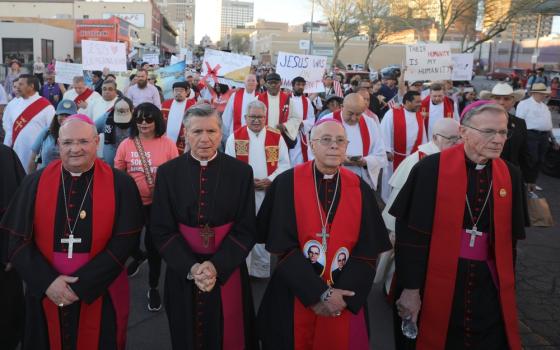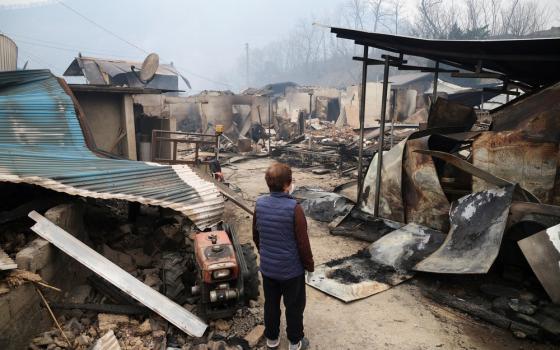
News Analysis
During a single week this month, Barack Obama agreed with Russian President Medvedev to negotiate a new nuclear arms treaty this year, told a big crowd in Prague that he would seek a ban on all nuclear tests as part of a global non-proliferation strategy and emphasized his goal of a world without nuclear weapons. Meanwhile, North Korea fired a rocket over Japan into the Pacific in what was widely seen as a test of a long-range missile that someday could carry a small nuclear warhead.
These events highlight both the dangers of a nuclear-armed world and the emergence of Obama as the most pro-disarmament president of the nuclear age.
Overkill lives on in the 21st century. Eight nations today possess over 23,000 nuclear warheads and bombs of all sizes — and that's a sizable reduction from the Cold War high. About 96 percent of these weapons of mass destruction belong to Russia and the United States, some of them on hair-trigger alert. France, China, Great Britain, Israel, India and Pakistan have much smaller nuclear arsenals. Israel, India and Pakistan didn't sign the Nuclear Non-Proliferation Treaty (NPT), which since 1970 has been the main diplomatic bulwark against the spread of nuclear weapons.
The world's non-proliferation structure is very wobbly. The NPT and its enforcement arm, the International Atomic Energy Agency, proved unable to prevent North Korea from testing a nuclear weapon and declaring itself a nuclear-weapon state. Pyongyang has also sold missiles to Iran, Pakistan, Syria, Libya and Yemen. Iran's “peaceful” nuclear program, which its neighbors and the West fear isn't all that peaceful, moves ahead despite international sanctions. If North Korea and Iran manage to build even small nuclear arsenals, experts predict a “cascade” of nuclear-arms efforts among their neighbors. In addition to governments, terrorists may be seeking nuclear or radioactive materials. As Obama said in Prague, “Black market trade in nuclear secrets and nuclear materials abounds. The technology to build a bomb has spread.”
At home, the Bush administration bequeathed to Obama a nuclear-weapons doctrine that broadened the mission for these arms far beyond deterrence. And the Senate, which must ratify arms agreements by a two-thirds vote, harbors many Republicans whose sympathy for such agreements has yet to be seen.
The good news is that the massive, cataclysmic “two scorpions in a bottle” dangers of the Cold War have passed. Whatever differences persist between Russia and the United States, the two nations are not about to threaten each other with nuclear weapons. The bad news is that more countries could batter down the front door to the Nuclear Club, while terrorists could sneak in through the back door and grab stuff off the table. The Doomsday Clock of the Bulletin of the Atomic Scientists, which was once at one minute to midnight, is now set at five minutes to. Enough for a breathing space, but only if action is taken.
Against that troubling background, candidate Obama affirmed last September, “As President, I will set a new direction in nuclear-weapons policy and show the world that America believes in its commitment under the Nuclear Non-Proliferation Treaty to work to ultimately eliminate all nuclear weapons.” The governments signing that treaty a generation and a half ago undertook to pursue negotiations leading to nuclear disarmament and “a treaty on general and complete disarmament under strict and effective international control.”
Obviously, no government ever pursued general and complete disarmament; efforts at nuclear disarmament were sporadic, limited and subject to Cold War fears and distrust. Obama's September statement, in answer to a questionnaire from Arms Control Today, also advocated “real, verifiable reductions in all U.S. and Russian nuclear weapons — whether deployed or non-deployed — whether strategic or non-strategic.” That level of specificity showed Obama's awareness of the thousands of Russian and U.S. nuclear weapons held in reserve and many smaller ones still deployed for battlefield use in Europe.
In a speech at DePaul University last October, the future president pledged to lead a global effort to secure nuclear weapons and material at unprotected sites, end production of fissile material, take nuclear weapons off hair-trigger alert, renounce new weapons production, and seek a global ban on the development, production and deployment of intermediate-range missiles.
Once elected, Obama repeated these pledges on the White House Web site, in both his name and Vice President Joe Biden's.
Obama started to act on these pledges at the April G-20 summit. Following an exchange of letters and phone calls, Obama and Medvedev agreed in London to begin work on a new strategic (long-range) weapons treaty to replace one expiring December 5. “We committed our two countries,” the presidents' joint statement declared, “to achieving a nuclear-free world, while recognizing that this long-term goal will require a new emphasis on arms control and conflict resolution measures, and their full implementation by all concerned nations.”
Despite the Russians' anxiety over the eastward expansion of NATO and the prospect of an American antimissile system in Poland and the Czech Republic, Medvedev joined Obama in working toward a significant reduction of nuclear arms. Two concurrent treaties now limit Russian and U.S. nuclear weapons. One, the Strategic Arms Reduction Treaty (START), dating from the Bush I administration and providing on-site inspection and data disclosure, expires soon.
The second, the Treaty of Moscow, signed by George W. Bush and Vladimir Putin, would reduce the number of long-range nuclear warheads and bombs deployed by each country to a maximum of 2,200 by 2012. It contains no verification measures, however, and is silent on weapons held in reserve. The United States has already reached the 2,200 level.
The negotiators' new assignment is to substantially reduce the numbers of deployed weapons, perhaps down to 1,000-1,500 on each side, with verification. A bit of history may help put these numbers in perspective. When John Kennedy was entering the White House in 1961, a Pentagon study concluded that 100-200 relatively secure nuclear weapons could provide an adequate deterrent.
But the clock is running. Negotiators have only eight months to hammer out details of the new treaty and get it ratified — a daunting task. Perhaps when Obama visits Moscow in July, he and Medvedev will be able to agree on a treaty outline. Then, if final terms are not in sight by fall, START might be extended while negotiations continue.
In their joint statement, Obama and Medvedev also called for “international negotiations for a verifiable treaty to end the production of fissile materials for nuclear weapons.” On his own, Obama proposed creation of an international fuel bank to supply civilian nuclear reactors. Obama also promised to work for U.S. ratification of the Comprehensive Nuclear Test Ban Treaty, defeated by Senate Republicans in 1999.
When John Holum was asked what he had learned as director of the Arms Control and Disarmament Agency during the Clinton administration, he replied, “Republicans oppose arms control.” He was referring to GOP opposition to a ban on all nuclear tests, specifically the underground tests which had been excluded from the 1963 treaty signed by John Kennedy and Nikita Khrushchev. The Republicans claimed in 1999 that small underground tests would be undetectable and the nuclear stockpile would be unreliable without testing. The Obama administration will give Senate Republicans a chance to change their minds, but it will take a vigorous campaign of education and pressure, to be led by Vice President Biden, to move them.
In this effort Obama and Biden would do well to involve the former officials of Republican administrations who have since supported the goal of a nuclear-free world — George Shultz, Henry Kissinger, Lawrence Eagleburger, Frank Carlucci and Robert McFarlane.
If Russia is now a partner in the difficult pursuit of nuclear disarmament, Iran and North Korea clearly are not. Both feel threatened by what they see as a U.S. desire for regime change. At present Iran won't engage in bilateral talks, although Obama has taken the first steps to open a dialogue. North Korea “talks” by rattling missiles. At six-power negotiations, Pyongyang excels at using its nuclear-weapons program to extort international deliveries of food and fuel.
When dealing with Iran, Karim Sadjadpour of the Carnegie Endowment for International Peace advises the United States to focus on Supreme Leader Ayatollah Khamenei, “whose authority is far greater than that of President Mahmoud Ahmedinejad.” It will be hard to allay Khamenei's suspicions, Sadjadpour concedes; moreover, some hardline Iranian elites oppose reconciliation with the United States because that would diminish their influence. But, Sadjadpour adds, Obama's overtures will put pressure on the hardliners while strengthening pragmatists, who believe Iran can't fulfill its potential without the United States. An internal debate in Iran could influence Khamenei's response to Obama, but it will take time. Meanwhile, uranium enrichment continues in Iran, and the Israeli government ponders whether to bomb the Iranian nuclear facilities.
There is also a continuing policy struggle in Pyongyang between hardliners and pragmatists, reports veteran Asia scholar Selig Harrison. On his eleventh trip to Pyongyang recently, Harrison was firmly rebuffed by top officials when he asked about a theoretical “grand bargain.” Under such an accord, North Korea would surrender its 68 pounds of plutonium in return for a peace treaty ending the Korean war, normalization of relations, and food, energy and infrastructure aid.
Since Kim Jong Il's stroke in 2008, the hardliners have been in control. Only unattractive options remain for the United States and its allies. The least bad might be attempting to cap the number of North Korean nuclear warheads at the existing four or five while engaging in missile talks that seek to limit Pyongyang's delivery systems. It may be too late, however, to talk North Korea out of remaining the ninth nuclear-weapons state.
If dealing with Pyongyang and Tehran (plus a recession and two wars) were not enough, Obama must contend with the professional cynics. Their attacks have appeared on the op-ed page of the Washington Post. William Kristol, editor of the Weekly Standard, asserted that a nuclear-free world is possible only in “a world without war, or without threats of war.”
While acknowledging the value of practical arms control measures, Kristol called the “allure” of a nuclear-free world “an excuse for not acting against real nuclear threats.” What he had in mind was revealed in his criticism of Obama's response to the North Korean missile test: “...The United States will do nothing to destroy North Korea's nuclear or missile capabilities, or to topple its political regime.” Kristol is ready for another war.
“Ridding the world of nuclear weapons,” wrote Post columnist “Anne Applebaum, “would be very nice, but on its own it won't alter the international balance of power, stop al-Qaeda or prevent large authoritarian states from invading their smaller neighbors.” But a nuclear-free world won't come “on its own.” Relations among many nations will have to change before those arsenals are scrapped. It will be a long struggle.
Barack Obama began this quest in 2005 with a trip to Russia, Ukraine and Azerbaijan. He accompanied Senator Richard Lugar on an inspection tour of former Soviet nuclear, chemical and biological weapons facilities. The pair worked to strengthen the U.S.-Russian program that secures these facilities.
Today, Obama's vision is broader and longer-range. He acknowledges that he may not live to see his final goal attained. Yet, with the backing of a strong national security team Obama is making the control and reduction of nuclear weapons one of his administration's top priorities. He will host a summit of world leaders next year in Washington to make the effort global.
Sanford Gottlieb is the former executive director of the National Committee for a Sane Nuclear Policy (SANE). He is the author of Defense Addiction and Red to Blue: Congresman Chris Van Hollen and Grassroots Politics.



